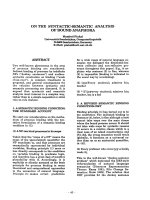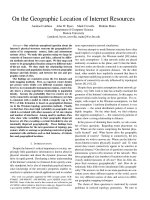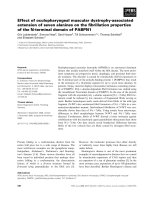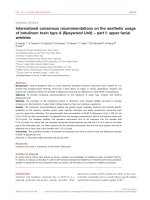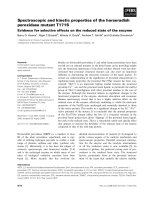SCHOPENHAUER ON THE EPISTEMOLOGICAL VALUE OF ART pot
Bạn đang xem bản rút gọn của tài liệu. Xem và tải ngay bản đầy đủ của tài liệu tại đây (73.97 KB, 10 trang )
Postgraduate Journal of Aesthetics, Vol. 5, No. 3, December 2008
S
CHOPENHAUER ON THE EPISTEMOLOGICAL VALUE OF ART
V
ID
S
IMONITI
C
HRIST
C
HURCH
,
U
NIVERSITY OF
O
XFORD
Art, as discussed in the third book of Arthur Schopenhauer’s The World as Will and
Representation, plays a double role in his philosophical system. On one hand,
beholding an object of aesthetic worth provides the spectator with a temporary
cessation of the otherwise incessant suffering that Schopenhauer takes life to be; on
the other, art creates an epistemological bridge between ourselves and the world as it
really is: unlike science which only studies relations between things, contemplation of
art leads to knowledge of that which is “alone really essential to the world, the true
content of its phenomena.” (WWR1: 184) It is this second aspect of Schopenhauer's
aesthetics that is both appealing and curious: while Schopenhauer's aesthetics and
epistemology are both rooted in his picture of the world as Will, which is (taken at
face value) deeply counter-intuitive, it yet seems to me that by assigning epistemic
value to art, he manages to capture the quality of profundity with which certain works
of art strike us – a profundity that is accounted for neither by reference to mere
enjoyment nor by reference to paraphrasable, propositional knowledge. It is this
tension between the plausible and extravagant elements of Schopenhauer's philosophy
of art that I will try to relieve in this paper. I will firstly point to the difficulties that
Schopenhauer's account runs into when we consider his treatment of Platonic Ideas,
and will then suggest a way in which Schopenhauer's insights about aesthetics can
still be preserved, if we separate them from a literal reading of his metaphysics.
The way in which Schopenhauer's account of the epistemic value of aesthetic
experience arises out of his metaphysical position can perhaps be best characterised
by invoking the two main points of difference between his idealism and that of Kant.
V
ID
S
IMONITI
20
For Schopenhauer, as for Kant, the world as representation (the world as we normally
perceive it) does not match the mind-independent, noumenal reality. Schopenhauer,
however, diverges from Kant in his explanation as to why this is so: for him, our
mode of perception is a consequence of the survival mechanism of the will and thus
the primary task of our perceptual organs and our mental capacities is to shape the
world as representation in such a way as to give best expression to our willing nature
(cf. WWR2: 284-5). The chief corollary of this is that even the most fundamental
features of the world as representation – the categories of space, time and causality –
are imposed upon the world for the purposes of the will. That is because it is only
through these categories that causal, spatial and temporal relations can obtain between
the willing subject and the objects of will: “only through these (relations) is the object
interesting to the individual, in other words, has it a relation to the will.” (WWR1:
177) Put otherwise, the world-will, acting through willing human subjects, structures
the world as representation so that a plurality of objects, individuated through the
categories of space, time and causality, appears. Such individuating of phenomena is
necessary for relations of willing to obtain between them.
Connected to this is Schopenhauer's second departure from Kant: he holds that it is
exceptionally possible to transcend the world as phenomena and come into contact
with reality: this happens in rare cases where a particularly developed human intellect
is able to lay aside the force that structures the world into the categories of space, time
and causality – the subject's own willing nature. For Schopenhauer, this profound shift
in perception which allows us to come into touch with the thing-in-itself is what
constitutes an aesthetic experience. This rare “objective tendency of the mind”, that is,
the ability to suspend the intellect's ordinary instrumental calibration and to
contemplate the world as it is in-itself, Schopenhauer calls “genius”. He writes:
[W]e relinquish the ordinary way of considering things, and cease to follow under the
guidance of the forms of the principle of sufficient reason [i.e. forms of space, time,
causality] merely their relations to one another, whose final goal is always the relation to
our own will. Thus we no longer consider the where, the when, the why, and the whither in
things, but simply and solely the what… (WWR1: 178)
These talented individuals are able to suspend their will in such a way as to observe
not particular objects in the world, such as particular clouds, but to perceive in them
V
ID
S
IMONITI
21
what is essential to them – as clouds were before they were made into individual
instantiations through the phenomenal matrix of space, time and causality. (WWR1:
185-6) But just as genius is unequally distributed among men, so there are also some
natural objects that exemplify the essential properties of their species better than
others. These objects are then more “beautiful” than others, since the essential, pre-
phenomenal nature of things is more easily grasped when it is beautiful objects that
are contemplated (WWR1: 209).
But what is it that is being thus contemplated? Schopenhauer equates objects when
they are known in-themselves with Platonic Ideas, which Schopenhauer views as
kinds of eternal species that display unchanging, essential characteristics of groups of
objects. For example, particular clouds and their many shapes are only phenomenal
and ephemeral, but the Idea of the clouds is “that as elastic vapour they are pressed
together, driven off, spread out, and torn apart by the force of the wind, this is their
nature, this is the essence of the forces objectified in them, this is the Idea.” (WWR1:
182) The genius's aesthetic knowledge, then, consists of direct perception of the
essential nature of a species of things, attained through will-less contemplation of
beautiful objects.
It may seem strange that Schopenhauer is trying to fit Platonic Ideas into his
system, and that it is them rather than the thing-in-itself (that is, the Will), which are
the objects of aesthetic knowledge. The reason for this is that for Schopenhauer the
very exercise of knowing presupposes a division of subject and object, whereas the
world-as-will is unindividuated (and thus unknowable). An Idea is
necessarily [an] object, something known, a representation, and precisely, but only, in this
respect is it different from the thing-in-itself[…] [I]t alone is the most adequate objectivity
possible of the will or of the thing-in-itself; indeed it is even the whole thing-in-itself, only
under the form of the representation.
(WWR1: 175)
However, while this might explain the need for an intermediary stage between
phenomena and reality, it does not seem self-evident why the subject-object division
should entail a multitude of Ideas (of clouds, panthers etc.), which correspond
unambiguously to the way ordinary language carves up the phenomenal world, rather
than to a simpler duality. We shall return to this difficulty later.
To return to the broader matter in question, where does art feature in this story?
The ability of a genius to perceive an Idea, even in its imperfect, particular instances,
enables her to create works of art: beautiful things that express “purely the Idea of
(their) species through the very distinct, clearly defined, and thoroughly significant
relation of (their) parts.” (WWR1: 210) For example, by observing real clouds, the
artist can create representations of beautiful, almost “Ideal” clouds. It is by
V
ID
S
IMONITI
22
contemplation of such works of art that perception of Ideas is more readily available
even to lesser minds. Therefore, the epistemic value of a work of art is that it
smoothens the contemplation of the Idea it represents: “The work of art is merely a
means of facilitating that knowledge in which this (aesthetic) pleasure consists.”
(WWR1: 195)
Knowledge of Ideas, then, involves a kind of direct perception of the essential, a
priori, nature of a species, before these are individuated into particular instantiations
by the principles of space, time and causality; and it is thus directly opposed to
knowledge of scientific concepts, which is knowledge of abstract generalisations
crafted by men a posteriori from observation of already individuated particulars.
(WWR1: 190, 233-6). Thus, knowledge of a perfect leopard gained from an artwork is
supposed to be different to and more profound than knowledge held by a zoologist
dealing with leopards. Good art portrays Ideas and not concepts – indeed the artist’s
knowledge of Ideas cannot be paraphrased in abstract, scientific terms, but can only
be communicated through unmediated perception of his work. (WWR1: 235)
We can now see just how radical Schopenhauer’s claims are. Firstly, knowledge of
the thing-in-itself is possible, and it is gained through the knowledge of the essential
nature of objects – Ideas. Secondly, this knowledge is not conceptual, but comes to us
directly through perception. And thirdly, this knowledge is to be gained through
disinterested contemplation of the works of art. Thus, not only is art epistemically
significant, but is also the source of the profoundest type of knowledge.
How plausible is all of this when applied to a particular work of art? Let's take a
promising example, Thomas Hardy's Proud Songsters. It may be felt particularly
appropriate not just because it is short, but because we know Hardy was himself
inspired by Schopenhauer in some of his writings.
Proud Songsters
The thrushes sing as the sun is going,
And the finches whistle in ones and pairs,
And as it gets dark loud nightingales
In bushes
Pipe, as they can when April wears,
As if all Time were theirs.
These are brand-new birds of twelve-months’ growing,
Which a year ago, or less than twain,
No finches were, nor nightingales,
Nor thrushes,
But only particles of grain,
And earth, and air, and rain.
V
ID
S
IMONITI
23
How does Schopenhauer's account of epistemic value of art apply here? Well, we may
note that there is some peculiar insight about these birds, the passing of seasons and
the way we perceive them that we obtain by reading the poem. This knowledge is not
empirical or similar to the knowledge of natural sciences: the merit of the poem does
not consist in merely adorning some statement about the nature of birds' breeding
cycles with rhyme and rhythm. Furthermore, the peculiar knowledge of the poem is in
a sense directly perceived in the poem – the poem is not a paraphrase, a conceptual
summing-up of the knowledge it yields to us. An attempt at a paraphrase of the
poem's content, such as “Everything in nature, including birds, often seems significant
and valuable, however, it is really just made of matter from which no such value can
be deduced, and this fact inspires in human beings a mixture of melancholia and
awe.” may count as a kind of interpretation, but is not equivalent to the direct
perception of the poem itself. The peculiarity of the knowledge inherent in the poem
is perhaps contained in the feeling that the poem is “profound”, expressing more than
its paraphrase. This seems well accounted for in Schopenhauer's account of Ideas: we
can explain such profundity by saying that Hardy's poem points us in the direction of
the Idea of those birds, as well as the Ideas of nature and existence more broadly.
However, while it seems to me that it is appropriate and worthwhile to talk, with
Schopenhauer, of the epistemic value of Hardy’s poem to account for its profundity,
problems might arise when one tries to probe further into the role played by
Schopenhauerian Ideas in this account. One might feel, and I think quite justifiably,
that talk of Ideas actually distracts from Schopenhauer’s main insight as to the
epistemic value of art, making the account needlessly complicated and dependent on a
rather murky ontological category. In particular, Ideas seem an odd concept because,
as facets of the thing-in-itself, they are supposed to be free of the categories of space,
time and causality; but, as soon as one considers what a particular Idea is supposed to
be, it becomes difficult to see how that could be the case. This difficulty can be
observed on Schopenhauer’s own examples of Ideas. For instance, if it is contained in
an Idea of a cloud that it behaves as an “inelastic, perfectly mobile, formless and
transparent fluid,” (WWR1: 182) or if it is the Idea of human history that certain types
of events always obtain (WWR1: 182-3), then it will seem at least curious to us that
these purportedly essential characteristics (e.g. elasticity and repetition of historical
events) all seem to be already familiar to us from the realm of space, time and
V
ID
S
IMONITI
24
causality; they already seem to exist in the world-as-representation.
1
It is my
impression that any further investigation into the nature of Ideas which would try to
resolve this apparent tension would have to work very hard if it is to avoid two
equally disagreeable options: either likening Ideas to run-of-the-mill empirical
generalizations or shrouding them in metaphysical mystery, depicting them as strange
categories that somehow happen to have both noumenal and phenomenal properties.
Both of these options bear implausible consequences for the corresponding aesthetic
theory: in the first case the knowledge of Ideas of finches, nightingales and thrushes
gained from Hardy’s poem is made akin to the knowledge of the birds’ general
features obtained from empirical observations, in the second it is knowledge of some
obscure metaphysical wonder that somehow connects to these birds. Neither of these
explanations, I think, does much to illuminate what goes on in an aesthetic
experience. It may be that one could try to secure a better concept of what Ideas are
and this may well be pursued by those more inclined than me to see such an
investigation as a fruitful one; however, given the unease I think I have shown we can
legitimately feel at any invocation of Ideas, coupled with the request that they be
understood not metaphorically but as genuine ontological or epistemic categories, it
seems to me that a Schopenhauerian theory of aesthetics would be better off if it did
not have to rely on this rather troublesome postulation. Can this be achieved?
Fortunately, there seem to be two senses in which Schopenhauer thinks art
communicates knowledge of the thing-in-itself, even though he himself does not
clearly distinguish between them. The first of these two senses is the one we have just
addressed, namely that knowledge of the thing-in-itself is available to us through
contemplation of Ideas that are portrayed in art. We have suggested that in this,
“essentialist” sense, the nature of the knowledge available in art is in fact left largely
unexplained, due to the problems arising from the obscure nature of the Ideas
themselves. However, there is another way in which art is supposed to communicate
knowledge of the thing-in-itself, namely by articulating the willing nature of objects
represented. I will call this other sense of Schopenhauer’s account the “will-in-art”
argument and it is this line of argument that I will pursue now.
Schopenhauer frequently rehearses this argument. For example, he writes that
animal portraiture is of interest because in animal painting “the phenomenon of will
1
A similar point is raised by Ivan Soll, see Soll (1998), p. 95.
V
ID
S
IMONITI
25
… is exhibited […] with a distinctness verging on the grotesque and monstrous”
(WWR1: 219), and that tragedy is to be placed above the other literary genres because
it best expresses “the antagonism of the will with itself.” (WWR1: 253) We could
imagine something similar being said about Hardy's poem. Now, Schopenhauer’s
claim that the value of art lies with its propensity to reveal the willing nature of the
world is not quite the same as his “essentialist” account. While the “essentialist”
account says that art communicates the perfect, Ideal ways in which phenomenal
things should be, the “will-in-art” argument says that art reveals the thing-in-itself (i.e.
the Will) by bringing to attention how the subject of the work of art is a phenomenal
instantiation of the principles of the World Will. As we have seen, to account for what
is special about aesthetic knowledge – how the understanding communicated by
Hardy’s poem is different from scientific, paraphrasable, empirical observations – the
plausibility of the “essentialist” story will depend on its being able to explain what the
objects of such knowledge, Platonic Ideas, are. The “will-in-art” view, however,
manages to account for the nature of aesthetic knowledge in a different way; the
special epistemic value of art arises from the fact that both the work of art and its
beholder are manifestations of the World Will:
The possibility of [the] anticipation of the beautiful a priori by the artist, as well as of its
recognition a posteriori by the connoisseur, is to be found in the fact that artist and
connoisseur are themselves the “in-itself” of nature, the will objectifying itself. (WWR1:
222)
By contemplating a work of art, the beholder becomes aware of the World Will
through a recognition of the willing nature of the artist’s subject; and this kind of
knowledge is markedly different from empirical knowledge. It is a product of a more
immediate, “partly a priori” (WWR1: 222) perception of the nature of the world (i.e.
as Will), of which we are already tacitly aware, being willing subjects ourselves. In
this respect Schopenhauer succeeds in showing that knowledge found in art is
markedly different from the a posteriori knowledge of science: art is profound
because it reveals to us something of the truth about its subject, which we have
already, on some hidden level, understood. The knowledge of finches, nightingales
and thrushes gained from the poem does not consist of learning some previously
unknown (empirical) fact about them, but rather consists in an apt reformulation of
V
ID
S
IMONITI
26
some already half-known truth of how things are, which we can agree to on the basis
of our own human experience.
However, are we now guilty of just substituting one moot metaphysical concept for
another? Is knowledge of the World Will any less odd than that of Platonic Ideas?
Again, I will waive the metaphysical discussion, and presume that it is preferable for
any Schopenhauerian aesthetic theory not to commit itself to any of his more
contentious metaphysical claims. Therefore, in the concluding remarks, I will briefly
sketch a proposal as to how one might sever Schopenhauer’s metaphysics and yet
keep his “will-in-art” account of the epistemic value of art largely intact.
My proposal can be best understood as a change of language in Schopenhauer's
account of world as Will rather than some dramatic overhaul of its content, and it
takes its cue from the mistake that Schopenhauer makes in his introspective discovery
of the thing-in-itself and his identifying it as Will. Schopenhauer first establishes that
we experience ourselves not only as empirical observables, but also as willing
subjects, and then he concludes that this inner experience of ours must also be the
‘content’ of the rest of our world (cf. WWR1: 117-8). However, it is surely much
simpler to describe Schopenhauer's introspection not as a discovery of some
underlying metaphysical primordial matter, but simply as a particular way in which he
experiences and characterizes human existence – as that of a willing subject. By the
same token, if Schopenhauer thinks that the epistemic value of art consists in
displaying the conflicting and striving nature of the world-as-will, it is much simpler
to think of art as contemplating the nature of our own existence. Although we may
wish to agree further with Schopenhauer in describing this existence as fundamentally
willing, wretched and self-defeating, we need not do so. Rather, we could leave the
exploration of the fundamentals of human existence to art itself or perhaps to a
separate philosophical investigation.
I have tried to show that it is human experience that provides the enduring appeal
of Schopenhauer's aesthetics, even if his metaphysical infrastructure may require
either an allegorical reading or complete removal. Once this has been achieved,
however, the account of the epistemic value of art is preserved intact, only that the
knowledge that art conveys no longer concerns the thing-in-itself but about our own
existential experience. Furthermore, what is retained from Schopenhauer is the direct,
unparaphrasable, “partly a priori” nature of knowledge gathered from such works of
art; the onlooker, himself a part of the human race whose condition is being portrayed,
V
ID
S
IMONITI
27
can recognise reflections of his own urges, strivings and experiences in the art he
contemplates. Something already half-known, half-felt, “profound” is elucidated for
her by art.
As a postscript, perhaps something still needs to be said regarding the limitations
of the claims we are making. While Schopenhauer (as illustrated by his discussion of
the many different areas of art, from horticulture and animal portraiture to classical
tragedy) arguably intended his theory to cover art universally, I think it would be
doubtless futile on his or anyone's behalf to try to provide necessary and sufficient
conditions that would cover everything that we are willing to call “a piece of art.” In
that sense, to say that all art speaks of the human condition is either false of
uninformative. Likewise, it would be wrong to say that the content, the human
experience, communicated is the same in all works of art – Proud Songsters is of
course not a paraphrase of Antigone. Rather than making such bold claims,
Schopenhauerian aesthetics should instead be taken as saying something about the
peculiar impression of profundity that strikes us when contemplating some works of
art, and its merit is to account for this profundity without referring to either pleasure,
institutionalism or relaying of a conceptual message, but by reference to an
articulation of a particular, unifying experience shared by the artist and her audience.
V
ID
S
IMONITI
28
R
EFERENCES
H
ARDY
,
T. (2001). ‘Proud Songsters’, in T. Paulin (ed.) Poems Selected by Tom
Paulin. (London: Faber & Faber).
S
CHOPENHAUER
,
A.
(1969a) The World as Will and Representation, Vol. 1. Trans.
E.F.J. Payne. (New York: Dover Publications). Cited as WWR1.
– (1969b) The World as Will and Representation, Vol 2. Trans. E.F.J. Payne. (New
York: Dover Publications). Cited as WWR2.
S
OLL
,
I.
(1998). ‘Schopenhauer, Nietzsche, and the Redemption of Life through Art’,
in C. Janaway (ed.) Willing and Nothingness: Schopenhauer as Nietzsche’s Educator.
(Oxford: Clarendon Press): pp. 79-115.

